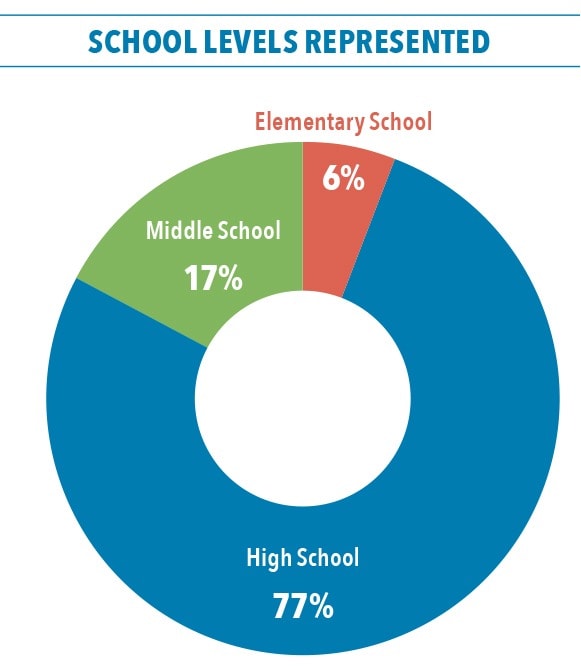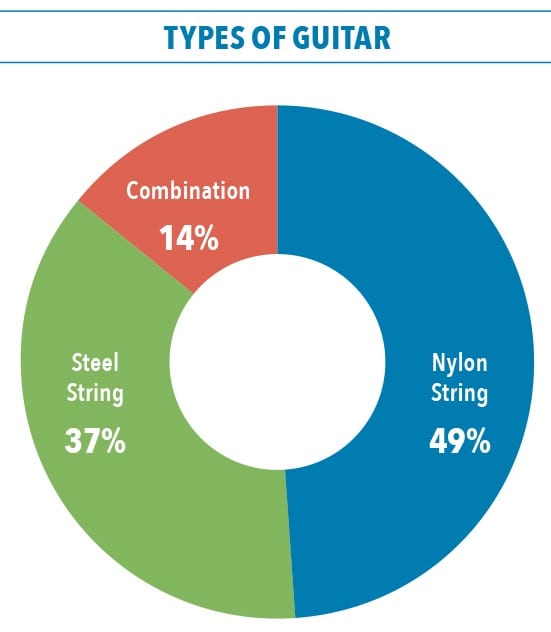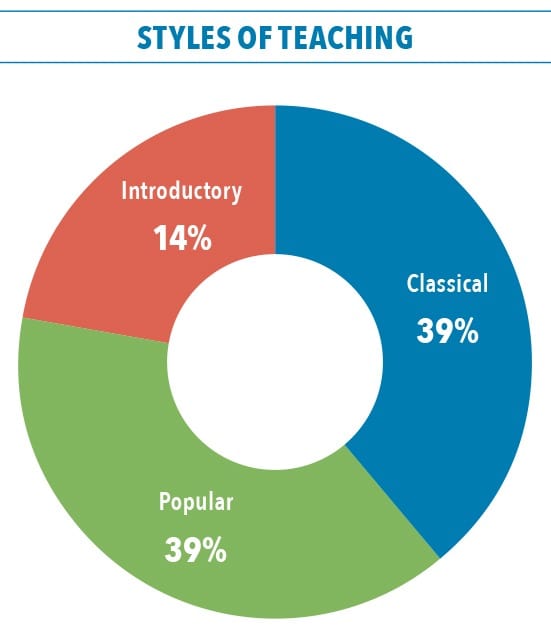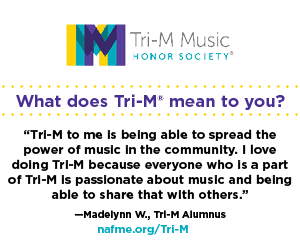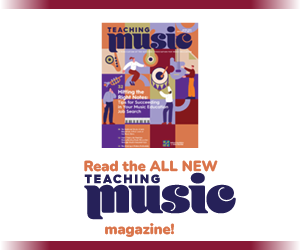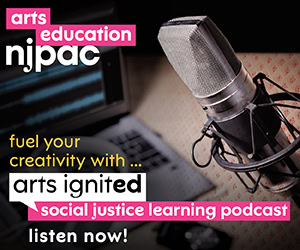/ News Posts / Observations of Guitar Class in 50 States
Observations of Guitar Class in 50 States
By NAfME Member Bill Swick
This article first appeared in the January 2021 issue of Teaching Music.
Guitar education reflects diversity and provides a common ground for all music educators to come together.
During his reign as NAfME Council for Guitar Education Chair (2018–2020), Thomas Amoriello, Jr. featured guitar classrooms throughout each month from each state. In his final article titled “Coda,” from his “Music in a Minuet” blog series, Amoriello writes:
Since November 2017, the Guitar Class in 50 States “Music in a Minuet” blog series has visited guitar educators in a variety of settings from elementary, middle, and high schools, private, parochial, preparatory, charter, magnet, and performing arts schools. Many colorful stories have shown the dedication of each teacher and the accomplishments of their students. In turn, these articles have helped guitar educators in isolated circumstances not feel completely alone and brought attention to some high functioning, award-winning programs. The feedback received via social media “likes, shares, and comments,” private email correspondence from respected educators and administrators, as well as reprints in various state music education journals are evidence that guitar education is here to stay and not a passing fad or novelty.
On many levels, the guitar has aided children emotionally and socially providing an outlet to the disinterested-in-school teenager and academic relief to the highly motivated college bound young leader with a schedule full of AP courses. Introverts and extroverts; gifted and talented, and students on academic probation; affluent and free-and-reduced lunch recipients; and all in between: Guitar education reflects diversity and provides a common ground for all to come together.

Image courtesy of Thomas Amoriello Jr.
Being a long-time guitar council member and a two-term chair, I have deep appreciation for Tom’s work on this project and see it as one of the outstanding contributions made by the NAfME Council for Guitar Education. I have read and reread every article and agree with Tom in that this is only the first step. What we do with this information and how we respond to one another is the next step. It has been my experience of isolation while teaching guitar in the classroom. Each one of us included in this project must feel alone on some days. Not only do we need to communicate with one another, we need to reach out to other music educators in our respective states and let them know we are here to help.
If it were not for guitar classes, a large sector of students would not receive any music education.
Tom’s greatest challenge in the project was to find a music educator offering guitar in a classroom in each state. To make the challenge even harder, each educator must be a member of NAfME. While each story is different, there are many similarities among us. This article is an effort to compare what is the same and what is different.
For starters, we are all 100 percent music educators, 100 percent members of NAfME, and 100 percent actively teaching guitar in the classroom. That is a lot to have in common. Knowing we each belong to a special group of educators is something to be proud of.
We all tend to agree that the students attracted to guitar classes are not interested in band, choir, and/or orchestra. If it were not for guitar classes, a large sector of students would not receive any music education. We agree that guitar classes have saved a percentage of students who come to school only because of the guitar class. We also agree that band, choir, and orchestra students tend not to drop these music classes to take a guitar class. Overall, we overwhelmingly agree that guitar classes have increased the number of students receiving music education in each of our schools.
Let us look at some other numbers. From this project, 77 percent of us teach high school, 17 percent teach middle school, and 6 percent teach elementary.
From our group, 62 percent would be defined as performance-based, meaning that we perform concerts either on campus and in the community or both. About 51 percent of the featured programs rehearse and perform as a large ensemble, sometimes referred to as a guitar orchestra. Interestingly, the programs that perform as large ensembles tend to come from the east and west coastal states and the states located below the 40-degree north latitude.
Only 57 percent of us teach note reading of modern notation. Compared to band and orchestra, this number seems really low. Many school band websites not only promote note reading as being extremely important, but also consider sight reading as an important skill for musicians to learn as early as possible. It is confusing why this does not transfer to guitar class considering 68 percent of us also teach band, choir, or orchestra.
While this next number is not absolute, approximately 50 percent of us have attended one or more Teaching Guitar Workshops. This number may be higher. It was not a question, but many of us volunteered that we had attended at least one Teaching Guitar Workshop and credited the experience for getting started.
Another number that is not absolute and approximately 50 percent are the number of teachers who write their own arrangements, texts, and/or teaching materials. Compared to band, choir, and orchestra, this number seems quite high. Because it is approximate, it could be even higher.
About 49 percent of the programs featured use only nylon-string guitars, 37 percent of the programs use strictly steel-string guitars, and 14 percent use a combination of both.
An impressive 43 percent of us are active members of the Guitar Foundation of America. Interestingly, 41 percent of the teachers who majored in guitar are teaching only guitar classes—no other subjects, just guitar. Of the entire group, only 30 percent of us are teaching only guitar classes.
Here is where we are perfectly divided: 39 percent of the guitar programs are structured as classical, focusing on posture, tone production, technique, and hand positions; 39 percent of the guitar programs are defined as playing only popular music; and 22 percent of the programs are strictly introductory. Some of these programs are from the elementary schools, which is perfectly understandable. Others are from exploration classes, which are only nine weeks long. Removing the 22 percent from this category means that collectively, we are perfectly divided between teaching a classical approach and teaching a popular music approach. Popular music includes folk songs, blue grass, blues, rock, jazz, original compositions, etc.
From our group, 32 percent of us majored in guitar, or guitar was our main instrument in college. Those of us majoring in guitar live in a variety of states, not geographically grouped like one may think.
While this is approximate, around 30 percent mentioned they include instruction in ukulele, mandolin, and/or banjo in their programs.
Since these articles were published, 10 percent of the featured teachers have left their school or the profession. These articles featuring each of us are published in multiple places, including the worldwide web where anyone can read them including parents, supervisors, administrators, other teachers from around the world, superintendents, politicians, etc.
While we have a lot in common, we are clearly divided in the philosophy about the importance of beginning guitar. Collectively, we have a wide spectrum of how we see the importance of beginning guitar class. Some of us approach beginning guitar class as a “hum and strum,” while others approach beginning guitar at the same level of beginning band or orchestra, stressing the importance of posture, hand positions, technique, and tone production. Some of us are somewhere in the middle.
It is with great hope, when given opportunities to describe our programs publicly, that we may be mindful that the future of guitar education will be built from our successes and model programs.
Notes from the Field
Here is a short list of some outstanding quotes found in our articles. Many comments demonstrate our philosophy.
“Addressing popular music in the classroom: This is a gap from which music education suffers, and so students tend to see art music as a mere reflex indicative of subjective taste, rather than an elevated form of the practice of music.”
—Andrew Stroud, Servitte High School, Anaheim, California
“The vast majority of the kids who sign up for my classes would have no interest in our music department if it wasn’t for my classes. These are the kids who didn’t take music classes in junior high. Learning to play the guitar or ukulele acts like bait to get them through the door, and they often go on to try other music classes once they’re here.”
—Kiel Schweizer, East High School, Anchorage, Alaska
“Beginning Guitar is perhaps the most important level of instruction. It is at this point that students form their initial understanding of sound production, posture, technique, literacy, and ability.”
—Dr. Kevin Vigil, Heritage High School, Leesburg, Virginia
“Guitar gave several struggling students something to look forward to on a daily basis.”
—Vicki Boyle, Mt. Hope High School, Bristol, Rhode Island
“Try to give guitar as much attention as you would give band, orchestra, choir, or whatever else you are offering. Get your kids performing as often as you can — take them to give concerts for the senior citizen communities or the kindergarten class or anywhere that you can bring a smile to someone!”
—Karen Dooley, Sioux Falls Lutheran School, Sioux Falls, South Dakota
“If we really want comprehensive music education, we must keep finding new ways to engage all students in music and not just the traditional music offerings of band, orchestra, and choir. My belief is that we are supposed to be music educators. Instead, colleges produce band teachers, orchestra teachers, and choir teachers. In this scenario, only half to two-thirds of your high school students ever receive any music education. Between guitar and our music technology program, we have increased enrollment in our department and staffing.”
—Mark Czech, Hopkins High School, Minneapolis, Minnesota
“The part that makes me sad is the fact that only an exceedingly small percentage of music colleges and universities are offering music education degrees for guitarists. Offering guitar at the pre-college level is really a good idea, but the colleges are not providing prepared guitar teachers to go out into the world to teach guitar. That is the biggest reason music educators are teaching guitar as a secondary instrument. My wish is for colleges and universities to promote music education for guitar players and prepare solid teachers to meet the needs of the many pre-college students who wish to study guitar as a music choice.”
—Bill Swick, Las Vegas Academy, Las Vegas, Nevada
“I do feel that guitarists should teach guitar. As for teaching technique, the most essential concern is proper guitar/body positioning, the foundation of all technical growth (no matter what musical direction the student ultimately takes). This includes alignment, follow-through, mid-range positioning, and uniform direction of movement, which should be well demonstrated and continually monitored. For teachers new to the guitar, I recommend taking lessons with a professional guitarist first and always being at least several steps ahead of your students as you work with them.”
—Alan Hirsh Bishop, McGuinness High School, Kernersville, North Carolina
“Why teach guitar even though you do not play guitar?
- It’s an outlet for you to teach something different—but not too different. It is music, but it is a non-familiar instrument.
- It gets you into the mainstream of students at your school. In many cases, band directors teach a small niche of students for four years at a school, never really seeing any other students. Similarly, mainstream students never get to see you otherwise.
- Guitar may provide feeder students for other aspects of your program.
I have had guitar class as something to fill my day and something to fill the student’s day. That’s not the best reason for offering a course. But, since the large-scale band and/or choral programs seem to be on the decline—and guitar is a popular part of everyday culture (and more economical than band instruments)—we educators may have to adjust as well. And no matter the reason for offering the course, it is a chance to interact and teach the youth of our country, which is always a great reason.”
—Glenn Scheuermann, Woodlawn High School, Baton Rouge, Louisiana
“There have been times when I’ve been hired to teach a guitar class of students whom a previous general music instructor has been teaching, and the children have been grossly misinformed about technique. Undoing that sort of problem is not only extremely challenging for the teacher, but it is also very frustrating and discouraging to the students. And at that age, it can really negatively affect their relationship with music going forward.”
—Bob Dellureficio, Harlem School of the Arts, New York, New York
“Guitar was not a part of my daily life. When I returned to college to get my teaching license, I was required to take method courses in every instrument except guitar. It was not a requirement for the music education degree. How ironic that the one method class that wasn’t required was the one that I ended up needing the most.”
—Allison Cowan, Centennial High School, Franklin, Tennessee
About the author:
 NAfME member Bill Swick is director of the Las Vegas Academy Guitar Program. He was the conductor of the 2019 All-National Honor Ensembles Guitar Ensemble. He is a past chair of the NAfME Council for Guitar Education and author of Teaching Beginning Guitar Class: A Practical Guide.
NAfME member Bill Swick is director of the Las Vegas Academy Guitar Program. He was the conductor of the 2019 All-National Honor Ensembles Guitar Ensemble. He is a past chair of the NAfME Council for Guitar Education and author of Teaching Beginning Guitar Class: A Practical Guide.
Did this blog spur new ideas for your music program? Share them on Amplify! Interested in reprinting this article? Please review the reprint guidelines.
The National Association for Music Education (NAfME) provides a number of forums for the sharing of information and opinion, including blogs and postings on our website, articles and columns in our magazines and journals, and postings to our Amplify member portal. Unless specifically noted, the views expressed in these media do not necessarily represent the policy or views of the Association, its officers, or its employees.
April 1, 2021. © National Association for Music Education (NAfME.org)
Published Date
April 1, 2021
Category
- Diversity, Equity, Inclusion, and Access (DEIA)
- Ensembles
Copyright
April 1, 2021. © National Association for Music Education (NAfME.org)

